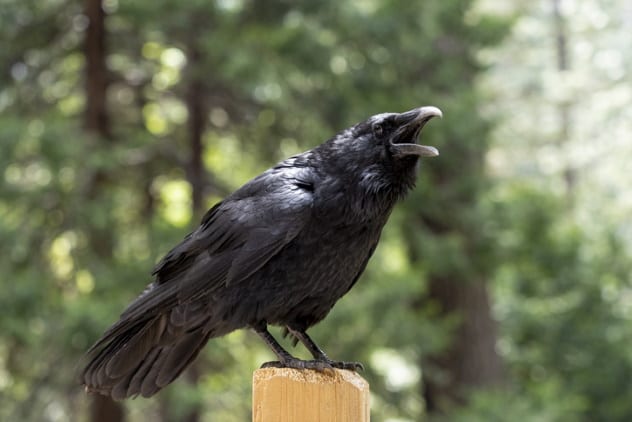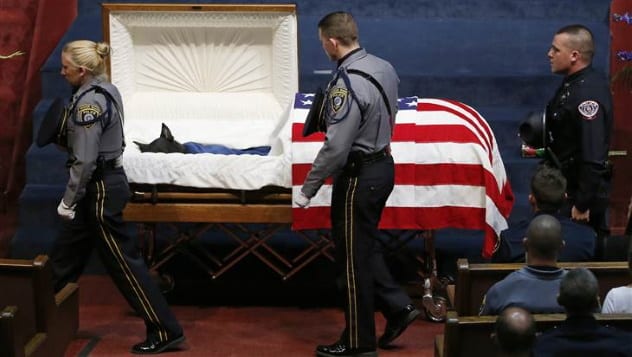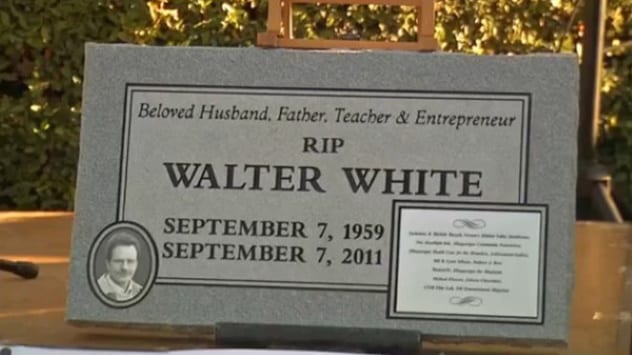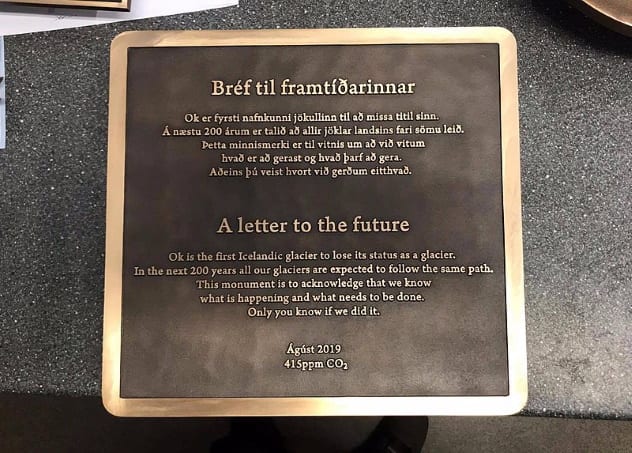 Movies and TV
Movies and TV  Movies and TV
Movies and TV  Health
Health 10 Miraculous Advances Toward Curing Incurable Diseases
 Miscellaneous
Miscellaneous 10 Undeniable Signs That People’s Views of Mushrooms Are Changing
 Animals
Animals 10 Strange Attempts to Smuggle Animals
 Travel
Travel 10 Natural Rock Formations That Will Make You Do a Double Take
 Movies and TV
Movies and TV 10 Actors Hidden in Your Favorite Movies
 Our World
Our World 10 Science Facts That Will Change How You Look at the World
 Pop Culture
Pop Culture 10 Incredible Female Comic Book Artists
 Crime
Crime 10 Terrifying Serial Killers from Centuries Ago
 Technology
Technology 10 Hilariously Over-Engineered Solutions to Simple Problems
 Movies and TV
Movies and TV 10 Movie Adaptions That Brought Popular Songs to Life
 Health
Health 10 Miraculous Advances Toward Curing Incurable Diseases
 Miscellaneous
Miscellaneous 10 Undeniable Signs That People’s Views of Mushrooms Are Changing
Who's Behind Listverse?

Jamie Frater
Head Editor
Jamie founded Listverse due to an insatiable desire to share fascinating, obscure, and bizarre facts. He has been a guest speaker on numerous national radio and television stations and is a five time published author.
More About Us Animals
Animals 10 Strange Attempts to Smuggle Animals
 Travel
Travel 10 Natural Rock Formations That Will Make You Do a Double Take
 Movies and TV
Movies and TV 10 Actors Hidden in Your Favorite Movies
 Our World
Our World 10 Science Facts That Will Change How You Look at the World
 Pop Culture
Pop Culture 10 Incredible Female Comic Book Artists
 Crime
Crime 10 Terrifying Serial Killers from Centuries Ago
 Technology
Technology 10 Hilariously Over-Engineered Solutions to Simple Problems
10 Funeral Ceremonies For Something Other Than Humans
Funerals are a way for us to find closure for ourselves and to show our love for the departed one last time. All cultures have funeral rites of some kind, because we all feel the sting of death. These ceremonies help to cope with that pain and give respect for our departed loved ones.
Sometimes, though, those loved ones aren’t necessarily other people. We aren’t the only things that need to be mourned when we die. The following are ten funerals held for the passing of something that was not human.
10 Funeral For Departed Gaming Machines

Pachinko is a popular kind of arcade machine in Japan that is like a combination between a slot machine and a pinball machine. The player launches small metallic balls into the machine, and on rare occasions, the ball will find its way into a special spot that initiates a slot-machine style randomizer that can reward countless more metallic balls, which double as a currency that can traded for prizes. If you’re trying to get around local gambling laws, you can even exchange those prizes for money at a nearby counter.
These machines are so popular that one manufacturer had to retire and replace roughly 500,000 machines every year that broke from wear and tear. In 2001, the manufacturer, Heiwa, arranged for a fitting farewell—a funeral for all of those thousands of machines was held at a popular Buddhist temple. This funeral included incense, mourners in black suits, and chanting monks with flowers. Above the temple’s altar, where a photo of the deceased is usually displayed, was a golden Pachinko machine that represented all of its deceased brethren.
“As a manufacturer of pachinko machines, we want to offer our thanks to machines that have completed their work,” said a company representative at the event, Takayuki Uchiyama. He also added that the rites were not just for the machines themselves but for all those who used, worked on, or made them. “It’s a way of praying for all the people who are dead who were involved in pachinko.”[1]
9 Decommissioned Navy Vessels

Since 1775, more than 15,000 US Navy ships have outlived their usefulness and have been decommissioned from active use. But decommissioning a ship isn’t like tossing out a used toothpaste tube or placing a piece of furniture on the corner to be taken to the dump. These retired vessels were friends forged in battle, homes, and the setting for their sailors’ most rousing adventures and terrifying tribulations. The ships are inanimate objects, but they’re so much more than that. When a ship is decommissioned, it has a ceremony, not unlike a funeral. One such decommissioning ceremony took place in 2015 for the USS Rodney M. Davis, named after a sergeant who sacrificed his life for his fellows while in battle in Vietnam.
The ceremony was attended by the ship’s last serving crew, as well as past crew members, the family of Sergeant Davis, and Marines he served with, including some he personally saved. The last serving crew departed the ship in dress uniforms, Sergeant Davis’s daughters helped the crew bring down the colors, which included the American flag and a long commissioning pendant, and finally, the family of Rodney M. Davis was given a tour of the ship.
The final commanding officer of the ship, Commander Todd Whalen, wrote of the occasion, “By valor and arms, USS Rodney M. Davis and her crew have answered the call for 28 years. We honored Sgt. Davis by working together to boldly execute the mission, and we’ll carry his Bold Runner spirit with us for the rest of our lives.”[2]
8 Crows Hold ‘Funerals’ For Their Dead Brethren

When a crow dies, its body becomes the center of a gathering of its fellows. They surround the corpse, call out to each other, and give the body extra kinds of attention. This behavior is seen in crows, jays, magpies, and ravens. However, these rituals serve a more practical purpose than mourning the dead.
Crows are very intelligent birds and have been shown to remember threats and actively avoid anything associated with that threat. For example, during an experiment conducted by Kaeli Swift of the University of Washington, a number of feeding locations were set up that attracted crows. Then those same crows were exposed to a masked human holding a dead crow in their hands. These humans were “scolded” by the crows (an alert noise that warned other living crows of a dangerous threat). Later, the masked individuals would return without a dead crow, but the behavior stayed the same. The crows scolded the person and avoided the spot. This suggests that the crows identified the mask with the death of one of their own and that any location the masked person visited could also be dangerous to them.
When a murder of crows holds a “funeral,” then, it seems likely that they are sending out warning cries to their still-living fellows and searching the area for threats. Still, when Swift repeated her experiment with dead pigeons, the crows didn’t seem particularly bothered. They cared only about the death of one of their own.[3]
7 A Farewell For The Departing Souls Of Dolls
Japanese Shinto and Buddhist religions frequently share the common belief that all things have souls, and so when an item is to be destroyed, that soul is honored. Such was the case in 2017, when 20 individuals and a Buddhist monk performed a funeral ceremony for departing souls of dolls and stuffed animals, including Hello Kitty and Disney icons. These dolls were bound for the dumpster. The ceremony included a chant from the former owners alongside Buddhist monk Shingyo Goto, which included heavy incense.
“We believe a soul lives inside dolls, so I perform a service to take the spirits out of them and express the feeling of gratitude to them,” Shingyo Goto said. “All things have a soul in it regardless of what it is, from a needle, a pair of scissors to an egg, and we give thanks to those things. We have to have the feeling of appreciation for all things.”[4]
6 A Fittingly Green Ceremony For A Tree

On April 1, 2019, a tree’s life was tragically cut short in New York. This may not have seemed like a noteworthy event, as 15 billion trees are cut down in the prime of their life every year, but this tree was a symbol for all of its fallen brothers and sisters and had a name—Will O. Baum. Not only was an obituary written and published in his honor, but a funeral was held. The obituary included these notes on the deceased:
Mr. Baum was born on Arbor Day on April 25th, 1919 in Inwood, NY by Jan and Isaac Prescott. He grew with the Prescott Family and son Marvin. Will-O, as his friends called him, was a pillar of his community . . . literally. In his spare time, he liked to feed the birds, photosynthesize and sunbathe with his best friend Marvin. “Will-O loved helping kids reach new heights and see new perspectives. He also pined for the changing of the seasons . . . except for winter. Christmas always freaked him out.” According to friends, Mr. Baum tirelessly spent his entire life fighting against deforestation and was saddened by the state of the environment.[5]
A funeral was conducted at Judson Memorial Church in New York City for Will O. Baum and included a 25-part choir, poetry readings, and a New Orleans brass band. It was an event for bringing awareness to the plight of trees everywhere and the environmental crisis worldwide. The invitation included the advice:
Light fare and beverages provided. Please bring your own drinking bottle or cup; this is a zero-waste event. No single use plastic or paper products will be used.
WEAR GREEN IF YOU WANT TO BE FESTIVE.
5 Hari Kuyo, The Needle Memorial Ceremony

This ceremony, started in the Heian period at the imperial household in Japan, is a yearly event celebrated in honor of the service of needles used (and broken) throughout the year. It is largely attended by seamstresses and housewives at Shinto and Buddhist temples. It is the perfect example of the concept of properly and honorably disposing of items, not merely throwing them away. This is a concept seen repeatedly in Japanese culture. At one of many temples conducting the ceremony, four women dressed in traditional Nara period clothes dance in honor of Orihime, the heavenly weaver, and lucky paper amulets are distributed to attendees.
Those visiting the temple on this occasion are encouraged to take one of the needles laid out in front of the temple altar and place it upright into a block of konyaku jelly while offering up a prayer.[6] This practice is centuries old and brings together professionals, hobbyists, weavers, and tailors in order to symbolically offer thanks to the tools that empower them to work their trade.
4 Goodbyes To Man’s Best Friend

Pets hold a cherished place in the hearts of many people, so it is no small wonder that the pet funeral industry makes an estimated $100 million a year and is growing all the time, with an estimated 700 or more pet cemeteries in the United States alone.
“Sometimes I hear from people who say, ‘I lost both parents and I lost my pet. This is worse.’ ” said Ed Martin III, vice president of the Hartsdale Pet Cemetery and Crematory, one of the most famous of those 700. “ ‘I feel guilty about that. Am I normal?’ I can’t tell you how many times I’ve heard that comment.”[7]
One such pet funeral was for K9 unit Kye, a three-year-old police dog who died in the line of duty in 2014. She was stabbed to death by a burglary suspect during an altercation, and her funeral (pictured above) was attended by more than 1,000 people and dozens of other service dogs.
3 A Goodbye To Man’s Robotic Best Friend
In 1999, Sony released a futuristic new product called an AIBO (Artificial Intelligence Robot), which was a robotic dog that would wag its tail, dance, and even speak in later models. It was an expensive product, costing roughly $3,000 by today’s standards, but the first run of 3,000 units was sold out within 20 minutes.
In 2006, Sony announced that they would cease production of AIBO, which never attracted enough attention to be anything more than a niche item. Still, some 150,000 units were sold over those seven years. In 2014, Sony made a sobering announcement for all remaining AIBO owners: It would no longer support the product. No more repairs, no more spare parts. For AIBO owners who had grown attached their their robotic dogs, this meant one frightening thing—their dogs would eventually die.
However, great lengths were gone through to keep these robotic pets running, and a small but thriving business was started to repair failing units, but it was only possible by cannibalizing parts from other AIBOs. To honor these “organ donors,” Nobuyuki Norimatsu, the founder of an AIBO repair company named A-Fun, arranged for a funeral for the departed.
This funeral was held at a Buddhist temple for 17 sacrificed AIBO units, but as his business grew, so, too, did the number of AIBOs needed for parts. These robot funerals became a regular occurrence, and in 2018, one was held for 800 AIBOs. The head priest of the temple, Bungen Oi, said that the funerals were in line with Buddhist philosophy, “Even though AIBO is a machine and doesn’t have feelings, it acts as a mirror for human emotions.”[8]
2 A Funeral For A Fictional Character

Walter White is not a real person. He was a fictional character played by actor Bryan Cranston in a television series titled Breaking Bad. In the series, White is a high school chemistry teacher diagnosed with inoperable cancer who is motivated to make and sell methamphetamine so that his family will have money after he inevitably passes away.
Eventually, White died (or so it is generally assumed) in the series finale. Unlike most television deaths, this particular death resulted in a real-world landmark when fans of the show raised funds for and bought a grave site, an (empty) coffin, and gravestone for the character in Albuquerque, New Mexico, where Breaking Bad is set. In addition to raising money for the funeral, these fans raised an additional $17,000, which they donated to the health care of Albuquerque’s homeless. However, there were some in the city who were unhappy with the increased foot traffic the grave has brought to the graveyard that is the final resting place for their real-life loved ones.[9]
1 A Memorial For A Glacier

A glacier is a mass of snow and ice formed after years of excess snow accumulates. Basically, it’s a large snowdrift that never disappears because more snow is added to it faster than the snow can melt. After the snow and ice build up to a height of about 30 meters (100 ft), the huge accumulation typically begins to flow under its own weight. At this point, it qualifies as a glacier.
Iceland is a country of glaciers, with 269 named ones. In fact, around 11 percent of Iceland’s total surface area is comprised of these giant, flowing masses of ice. However, that is changing. As the world warms, glaciers are beginning to die off because more snow is melting from them than is added, causing them to shrink. In 2014, for the first time ever, a glacier was officially declared dead in Iceland—the iconic Okjokull, also referred to as “Ok.”[10]
To commemorate the life of this once-proud Icelandic natural feature, dozens of people from all over the country, including the prime minister, hiked to its former location on August 18, 2019, to leave a memorial for the dead glacier as well as a message for future generations. A copper plaque was installed at the location. It reads in both Icelandic and English:
Ok is the first Icelandic glacier to lose its status as a glacier. In the next 200 years all our glaciers are expected to follow the same path. This monument is to acknowledge that we know what is happening and know what needs to be done. Only you know if we did it.
Read about more unique funerals on 10 Strange And Fascinating Funerals Of Famous People and Top 10 Fascinating Funerals.








